Performance Improvement and Management in Health & Social Care - Desklib
VerifiedAdded on 2023/06/10
|18
|5178
|179
AI Summary
This project report covers the memorandum for the internal directors along with the pros and cons of two strategic planning models, usefulness of Du Pont analysis to shareholders, and interpretation of ratios along with brief explanation on purpose of each formula with calculation and comparison with industry average.
Contribute Materials
Your contribution can guide someone’s learning journey. Share your
documents today.
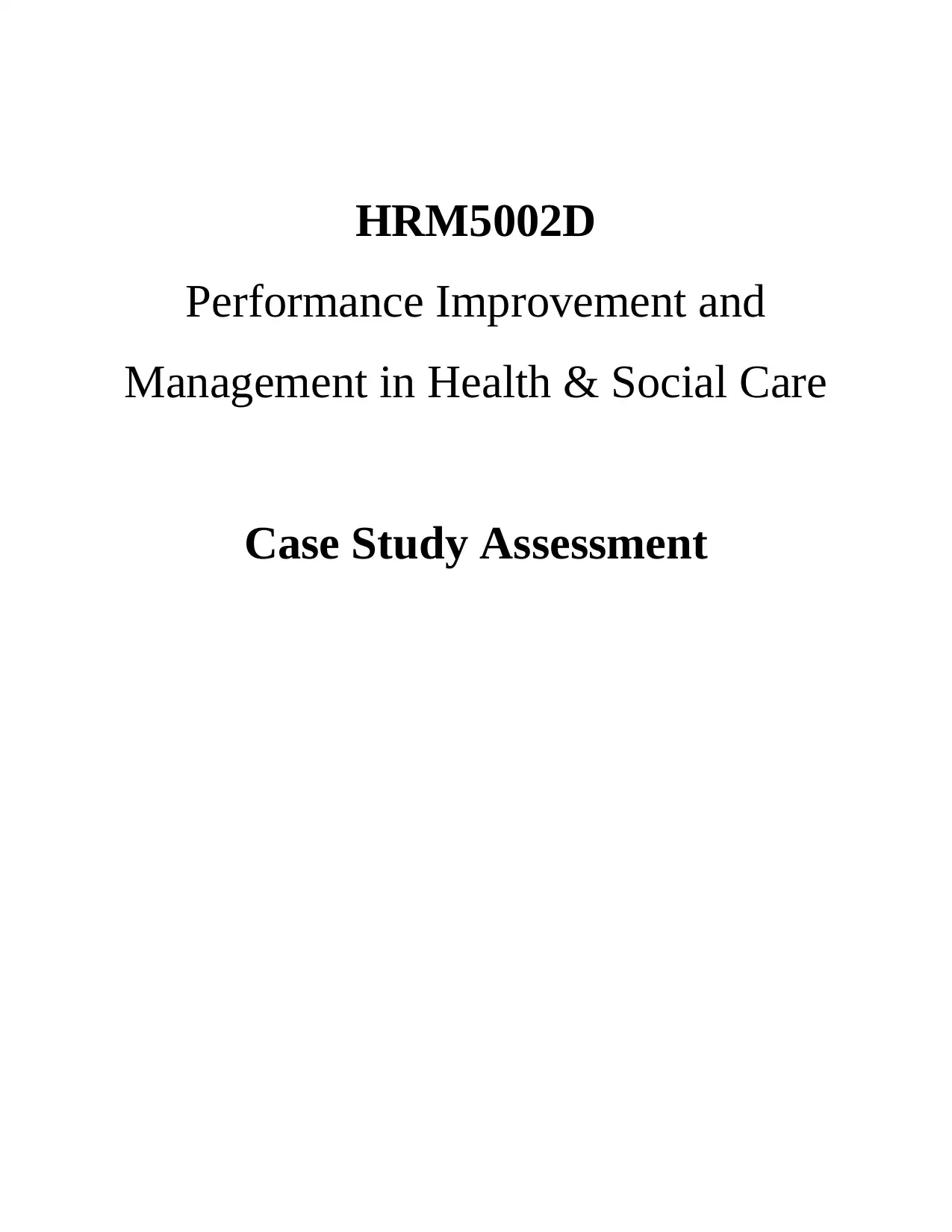
HRM5002D
Performance Improvement and
Management in Health & Social Care
Case Study Assessment
Performance Improvement and
Management in Health & Social Care
Case Study Assessment
Secure Best Marks with AI Grader
Need help grading? Try our AI Grader for instant feedback on your assignments.

Contents
INTRODUCTION...........................................................................................................................4
TASK...............................................................................................................................................4
Question No 1.........................................................................................................................4
Question No 2.........................................................................................................................8
Question No 3.......................................................................................................................13
CONCLUSION..............................................................................................................................17
REFERENCES..............................................................................................................................18
INTRODUCTION...........................................................................................................................4
TASK...............................................................................................................................................4
Question No 1.........................................................................................................................4
Question No 2.........................................................................................................................8
Question No 3.......................................................................................................................13
CONCLUSION..............................................................................................................................17
REFERENCES..............................................................................................................................18
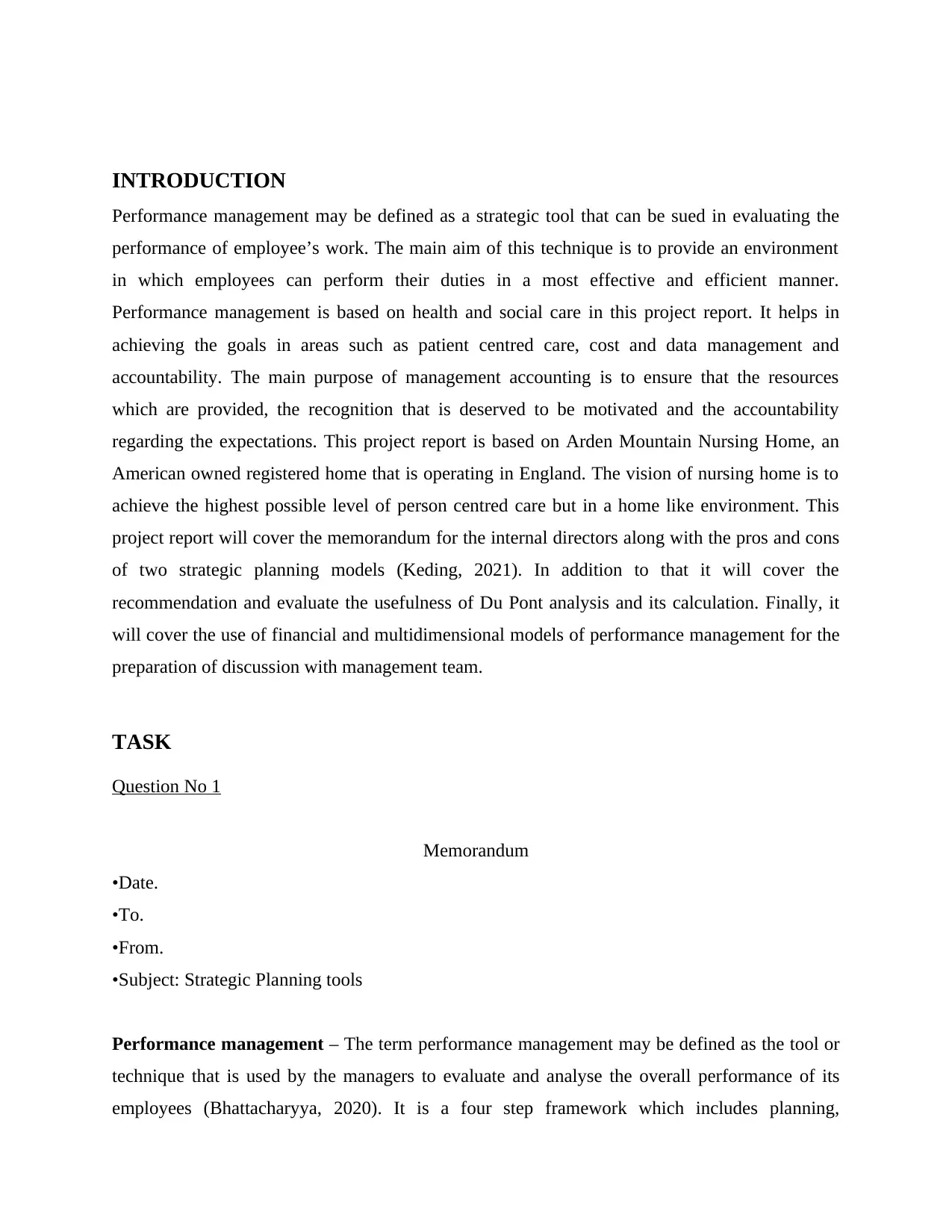
INTRODUCTION
Performance management may be defined as a strategic tool that can be sued in evaluating the
performance of employee’s work. The main aim of this technique is to provide an environment
in which employees can perform their duties in a most effective and efficient manner.
Performance management is based on health and social care in this project report. It helps in
achieving the goals in areas such as patient centred care, cost and data management and
accountability. The main purpose of management accounting is to ensure that the resources
which are provided, the recognition that is deserved to be motivated and the accountability
regarding the expectations. This project report is based on Arden Mountain Nursing Home, an
American owned registered home that is operating in England. The vision of nursing home is to
achieve the highest possible level of person centred care but in a home like environment. This
project report will cover the memorandum for the internal directors along with the pros and cons
of two strategic planning models (Keding, 2021). In addition to that it will cover the
recommendation and evaluate the usefulness of Du Pont analysis and its calculation. Finally, it
will cover the use of financial and multidimensional models of performance management for the
preparation of discussion with management team.
TASK
Question No 1
Memorandum
•Date.
•To.
•From.
•Subject: Strategic Planning tools
Performance management – The term performance management may be defined as the tool or
technique that is used by the managers to evaluate and analyse the overall performance of its
employees (Bhattacharyya, 2020). It is a four step framework which includes planning,
Performance management may be defined as a strategic tool that can be sued in evaluating the
performance of employee’s work. The main aim of this technique is to provide an environment
in which employees can perform their duties in a most effective and efficient manner.
Performance management is based on health and social care in this project report. It helps in
achieving the goals in areas such as patient centred care, cost and data management and
accountability. The main purpose of management accounting is to ensure that the resources
which are provided, the recognition that is deserved to be motivated and the accountability
regarding the expectations. This project report is based on Arden Mountain Nursing Home, an
American owned registered home that is operating in England. The vision of nursing home is to
achieve the highest possible level of person centred care but in a home like environment. This
project report will cover the memorandum for the internal directors along with the pros and cons
of two strategic planning models (Keding, 2021). In addition to that it will cover the
recommendation and evaluate the usefulness of Du Pont analysis and its calculation. Finally, it
will cover the use of financial and multidimensional models of performance management for the
preparation of discussion with management team.
TASK
Question No 1
Memorandum
•Date.
•To.
•From.
•Subject: Strategic Planning tools
Performance management – The term performance management may be defined as the tool or
technique that is used by the managers to evaluate and analyse the overall performance of its
employees (Bhattacharyya, 2020). It is a four step framework which includes planning,
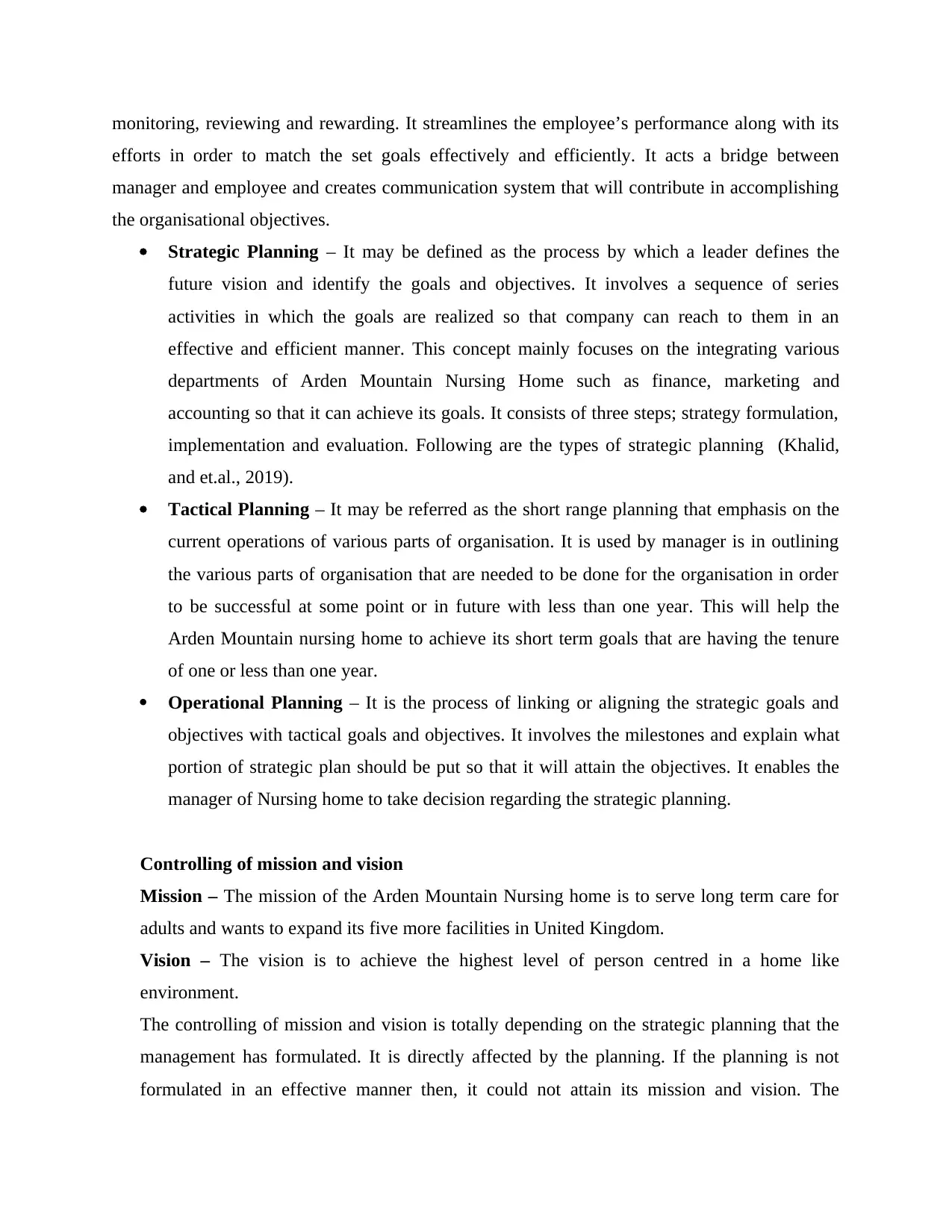
monitoring, reviewing and rewarding. It streamlines the employee’s performance along with its
efforts in order to match the set goals effectively and efficiently. It acts a bridge between
manager and employee and creates communication system that will contribute in accomplishing
the organisational objectives.
Strategic Planning – It may be defined as the process by which a leader defines the
future vision and identify the goals and objectives. It involves a sequence of series
activities in which the goals are realized so that company can reach to them in an
effective and efficient manner. This concept mainly focuses on the integrating various
departments of Arden Mountain Nursing Home such as finance, marketing and
accounting so that it can achieve its goals. It consists of three steps; strategy formulation,
implementation and evaluation. Following are the types of strategic planning (Khalid,
and et.al., 2019).
Tactical Planning – It may be referred as the short range planning that emphasis on the
current operations of various parts of organisation. It is used by manager is in outlining
the various parts of organisation that are needed to be done for the organisation in order
to be successful at some point or in future with less than one year. This will help the
Arden Mountain nursing home to achieve its short term goals that are having the tenure
of one or less than one year.
Operational Planning – It is the process of linking or aligning the strategic goals and
objectives with tactical goals and objectives. It involves the milestones and explain what
portion of strategic plan should be put so that it will attain the objectives. It enables the
manager of Nursing home to take decision regarding the strategic planning.
Controlling of mission and vision
Mission – The mission of the Arden Mountain Nursing home is to serve long term care for
adults and wants to expand its five more facilities in United Kingdom.
Vision – The vision is to achieve the highest level of person centred in a home like
environment.
The controlling of mission and vision is totally depending on the strategic planning that the
management has formulated. It is directly affected by the planning. If the planning is not
formulated in an effective manner then, it could not attain its mission and vision. The
efforts in order to match the set goals effectively and efficiently. It acts a bridge between
manager and employee and creates communication system that will contribute in accomplishing
the organisational objectives.
Strategic Planning – It may be defined as the process by which a leader defines the
future vision and identify the goals and objectives. It involves a sequence of series
activities in which the goals are realized so that company can reach to them in an
effective and efficient manner. This concept mainly focuses on the integrating various
departments of Arden Mountain Nursing Home such as finance, marketing and
accounting so that it can achieve its goals. It consists of three steps; strategy formulation,
implementation and evaluation. Following are the types of strategic planning (Khalid,
and et.al., 2019).
Tactical Planning – It may be referred as the short range planning that emphasis on the
current operations of various parts of organisation. It is used by manager is in outlining
the various parts of organisation that are needed to be done for the organisation in order
to be successful at some point or in future with less than one year. This will help the
Arden Mountain nursing home to achieve its short term goals that are having the tenure
of one or less than one year.
Operational Planning – It is the process of linking or aligning the strategic goals and
objectives with tactical goals and objectives. It involves the milestones and explain what
portion of strategic plan should be put so that it will attain the objectives. It enables the
manager of Nursing home to take decision regarding the strategic planning.
Controlling of mission and vision
Mission – The mission of the Arden Mountain Nursing home is to serve long term care for
adults and wants to expand its five more facilities in United Kingdom.
Vision – The vision is to achieve the highest level of person centred in a home like
environment.
The controlling of mission and vision is totally depending on the strategic planning that the
management has formulated. It is directly affected by the planning. If the planning is not
formulated in an effective manner then, it could not attain its mission and vision. The
Secure Best Marks with AI Grader
Need help grading? Try our AI Grader for instant feedback on your assignments.
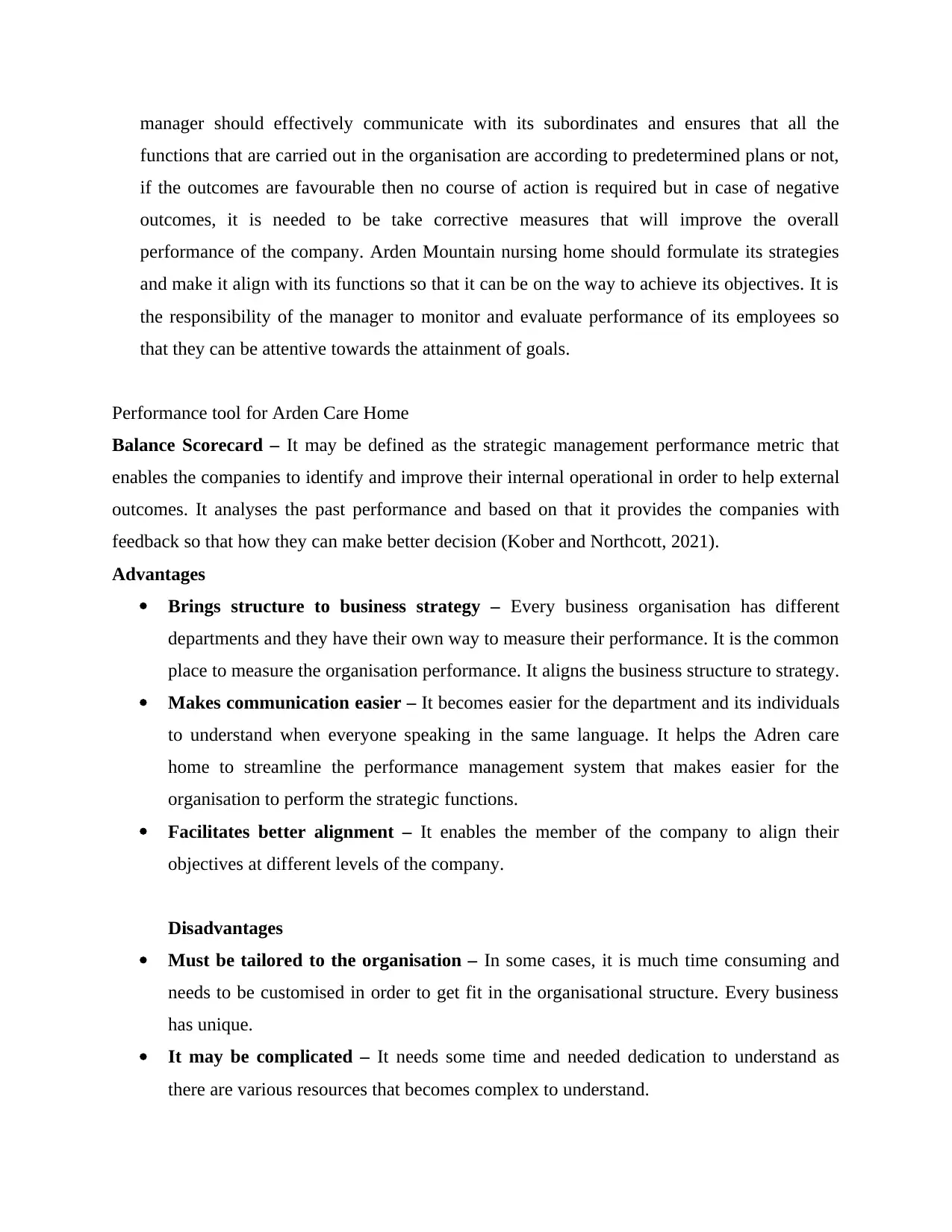
manager should effectively communicate with its subordinates and ensures that all the
functions that are carried out in the organisation are according to predetermined plans or not,
if the outcomes are favourable then no course of action is required but in case of negative
outcomes, it is needed to be take corrective measures that will improve the overall
performance of the company. Arden Mountain nursing home should formulate its strategies
and make it align with its functions so that it can be on the way to achieve its objectives. It is
the responsibility of the manager to monitor and evaluate performance of its employees so
that they can be attentive towards the attainment of goals.
Performance tool for Arden Care Home
Balance Scorecard – It may be defined as the strategic management performance metric that
enables the companies to identify and improve their internal operational in order to help external
outcomes. It analyses the past performance and based on that it provides the companies with
feedback so that how they can make better decision (Kober and Northcott, 2021).
Advantages
Brings structure to business strategy – Every business organisation has different
departments and they have their own way to measure their performance. It is the common
place to measure the organisation performance. It aligns the business structure to strategy.
Makes communication easier – It becomes easier for the department and its individuals
to understand when everyone speaking in the same language. It helps the Adren care
home to streamline the performance management system that makes easier for the
organisation to perform the strategic functions.
Facilitates better alignment – It enables the member of the company to align their
objectives at different levels of the company.
Disadvantages
Must be tailored to the organisation – In some cases, it is much time consuming and
needs to be customised in order to get fit in the organisational structure. Every business
has unique.
It may be complicated – It needs some time and needed dedication to understand as
there are various resources that becomes complex to understand.
functions that are carried out in the organisation are according to predetermined plans or not,
if the outcomes are favourable then no course of action is required but in case of negative
outcomes, it is needed to be take corrective measures that will improve the overall
performance of the company. Arden Mountain nursing home should formulate its strategies
and make it align with its functions so that it can be on the way to achieve its objectives. It is
the responsibility of the manager to monitor and evaluate performance of its employees so
that they can be attentive towards the attainment of goals.
Performance tool for Arden Care Home
Balance Scorecard – It may be defined as the strategic management performance metric that
enables the companies to identify and improve their internal operational in order to help external
outcomes. It analyses the past performance and based on that it provides the companies with
feedback so that how they can make better decision (Kober and Northcott, 2021).
Advantages
Brings structure to business strategy – Every business organisation has different
departments and they have their own way to measure their performance. It is the common
place to measure the organisation performance. It aligns the business structure to strategy.
Makes communication easier – It becomes easier for the department and its individuals
to understand when everyone speaking in the same language. It helps the Adren care
home to streamline the performance management system that makes easier for the
organisation to perform the strategic functions.
Facilitates better alignment – It enables the member of the company to align their
objectives at different levels of the company.
Disadvantages
Must be tailored to the organisation – In some cases, it is much time consuming and
needs to be customised in order to get fit in the organisational structure. Every business
has unique.
It may be complicated – It needs some time and needed dedication to understand as
there are various resources that becomes complex to understand.
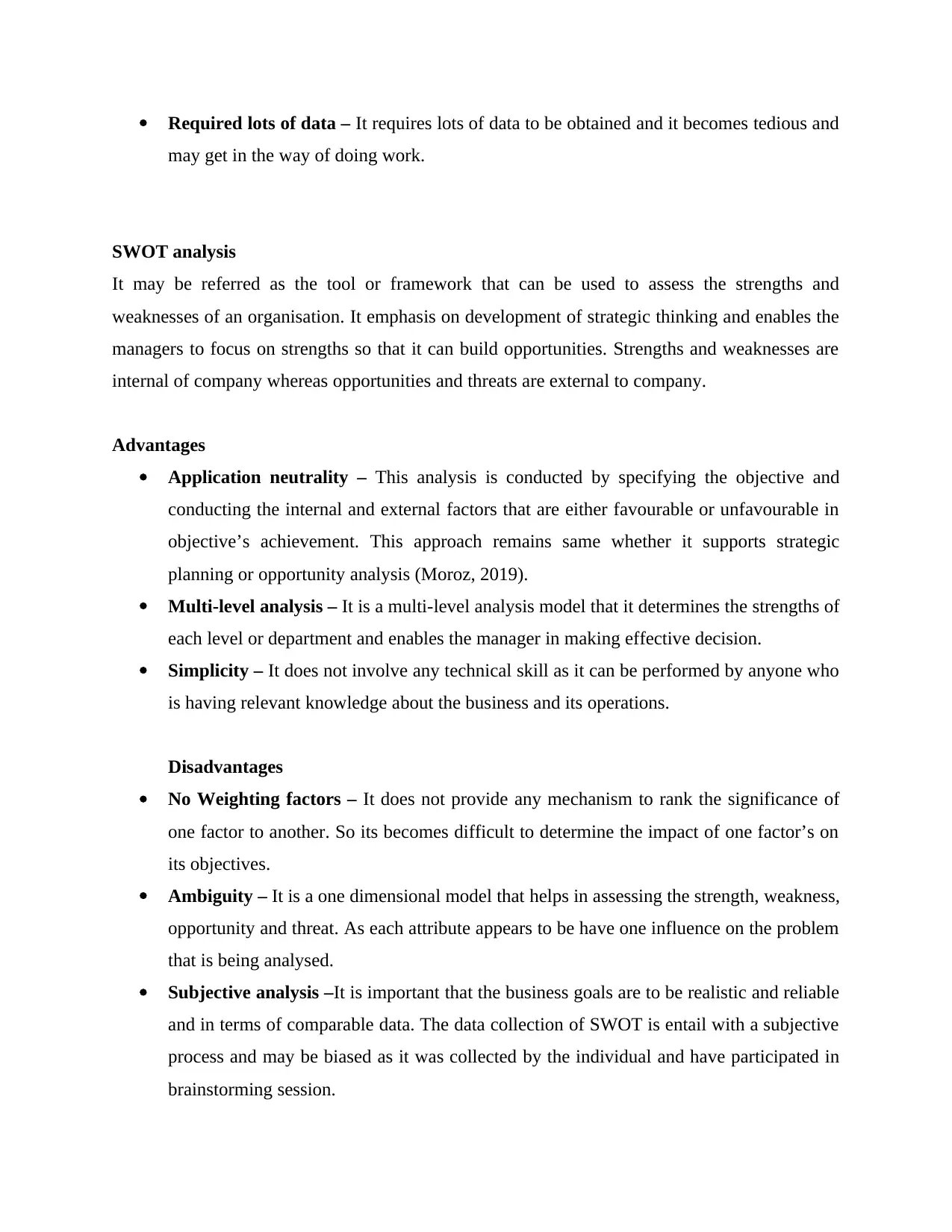
Required lots of data – It requires lots of data to be obtained and it becomes tedious and
may get in the way of doing work.
SWOT analysis
It may be referred as the tool or framework that can be used to assess the strengths and
weaknesses of an organisation. It emphasis on development of strategic thinking and enables the
managers to focus on strengths so that it can build opportunities. Strengths and weaknesses are
internal of company whereas opportunities and threats are external to company.
Advantages
Application neutrality – This analysis is conducted by specifying the objective and
conducting the internal and external factors that are either favourable or unfavourable in
objective’s achievement. This approach remains same whether it supports strategic
planning or opportunity analysis (Moroz, 2019).
Multi-level analysis – It is a multi-level analysis model that it determines the strengths of
each level or department and enables the manager in making effective decision.
Simplicity – It does not involve any technical skill as it can be performed by anyone who
is having relevant knowledge about the business and its operations.
Disadvantages
No Weighting factors – It does not provide any mechanism to rank the significance of
one factor to another. So its becomes difficult to determine the impact of one factor’s on
its objectives.
Ambiguity – It is a one dimensional model that helps in assessing the strength, weakness,
opportunity and threat. As each attribute appears to be have one influence on the problem
that is being analysed.
Subjective analysis –It is important that the business goals are to be realistic and reliable
and in terms of comparable data. The data collection of SWOT is entail with a subjective
process and may be biased as it was collected by the individual and have participated in
brainstorming session.
may get in the way of doing work.
SWOT analysis
It may be referred as the tool or framework that can be used to assess the strengths and
weaknesses of an organisation. It emphasis on development of strategic thinking and enables the
managers to focus on strengths so that it can build opportunities. Strengths and weaknesses are
internal of company whereas opportunities and threats are external to company.
Advantages
Application neutrality – This analysis is conducted by specifying the objective and
conducting the internal and external factors that are either favourable or unfavourable in
objective’s achievement. This approach remains same whether it supports strategic
planning or opportunity analysis (Moroz, 2019).
Multi-level analysis – It is a multi-level analysis model that it determines the strengths of
each level or department and enables the manager in making effective decision.
Simplicity – It does not involve any technical skill as it can be performed by anyone who
is having relevant knowledge about the business and its operations.
Disadvantages
No Weighting factors – It does not provide any mechanism to rank the significance of
one factor to another. So its becomes difficult to determine the impact of one factor’s on
its objectives.
Ambiguity – It is a one dimensional model that helps in assessing the strength, weakness,
opportunity and threat. As each attribute appears to be have one influence on the problem
that is being analysed.
Subjective analysis –It is important that the business goals are to be realistic and reliable
and in terms of comparable data. The data collection of SWOT is entail with a subjective
process and may be biased as it was collected by the individual and have participated in
brainstorming session.

Recommendation
From the above two strategic planning models the Arden should opt the balance scorecard
method s it will help in improving the overall performance of the company and assess the
department where it is lacking. This will enable the manager in taking effective decision as it
will contribute in accomplishing the mission and objectives of the nursing home. It is the detailed
analysis of company’s performance and provides with the way to accomplish the objectives. It
enables in defining the overall performance of the nursing home and the area where it lacks such
as in finance or in marketing department. By evaluating the performance, it helps in improving
the overall productivity of the employees. This will contribute in attaining the organisational
goals in an effective and efficient manner (Clarke, 2019).
Question No 2
a) Usefulness of Du Pont analysis to shareholders along with explanation on purpose of each
formula discussed below:
Usefulness of Du Pont Analysis to shareholders:
Du Pont analysis is the framework which is used to analysis the fundamental
performance of the business entity. It is considered to be the useful technique which is
used to fester multiple drivers of return on equity. The decomposition of ROE allows the
investor to focus on the important metrics relating to financial performance so that
strength and weakness can be identified (Bunea, Corbos and Popescu, 2019). The
formula of calculation Du Pont analysis is Net income / Revenue. This analysis would
support the investor and stakeholders of the entity to determine that what financial
activities are supporting the most to the changes made in the ROE. The Component of Du
Pont analysis are being net profit margin, asset turnover ratio and financial leverage.
Explanation on purpose of each formula along with calculations and interpretation comparing
industry average:
From the above two strategic planning models the Arden should opt the balance scorecard
method s it will help in improving the overall performance of the company and assess the
department where it is lacking. This will enable the manager in taking effective decision as it
will contribute in accomplishing the mission and objectives of the nursing home. It is the detailed
analysis of company’s performance and provides with the way to accomplish the objectives. It
enables in defining the overall performance of the nursing home and the area where it lacks such
as in finance or in marketing department. By evaluating the performance, it helps in improving
the overall productivity of the employees. This will contribute in attaining the organisational
goals in an effective and efficient manner (Clarke, 2019).
Question No 2
a) Usefulness of Du Pont analysis to shareholders along with explanation on purpose of each
formula discussed below:
Usefulness of Du Pont Analysis to shareholders:
Du Pont analysis is the framework which is used to analysis the fundamental
performance of the business entity. It is considered to be the useful technique which is
used to fester multiple drivers of return on equity. The decomposition of ROE allows the
investor to focus on the important metrics relating to financial performance so that
strength and weakness can be identified (Bunea, Corbos and Popescu, 2019). The
formula of calculation Du Pont analysis is Net income / Revenue. This analysis would
support the investor and stakeholders of the entity to determine that what financial
activities are supporting the most to the changes made in the ROE. The Component of Du
Pont analysis are being net profit margin, asset turnover ratio and financial leverage.
Explanation on purpose of each formula along with calculations and interpretation comparing
industry average:
Paraphrase This Document
Need a fresh take? Get an instant paraphrase of this document with our AI Paraphraser
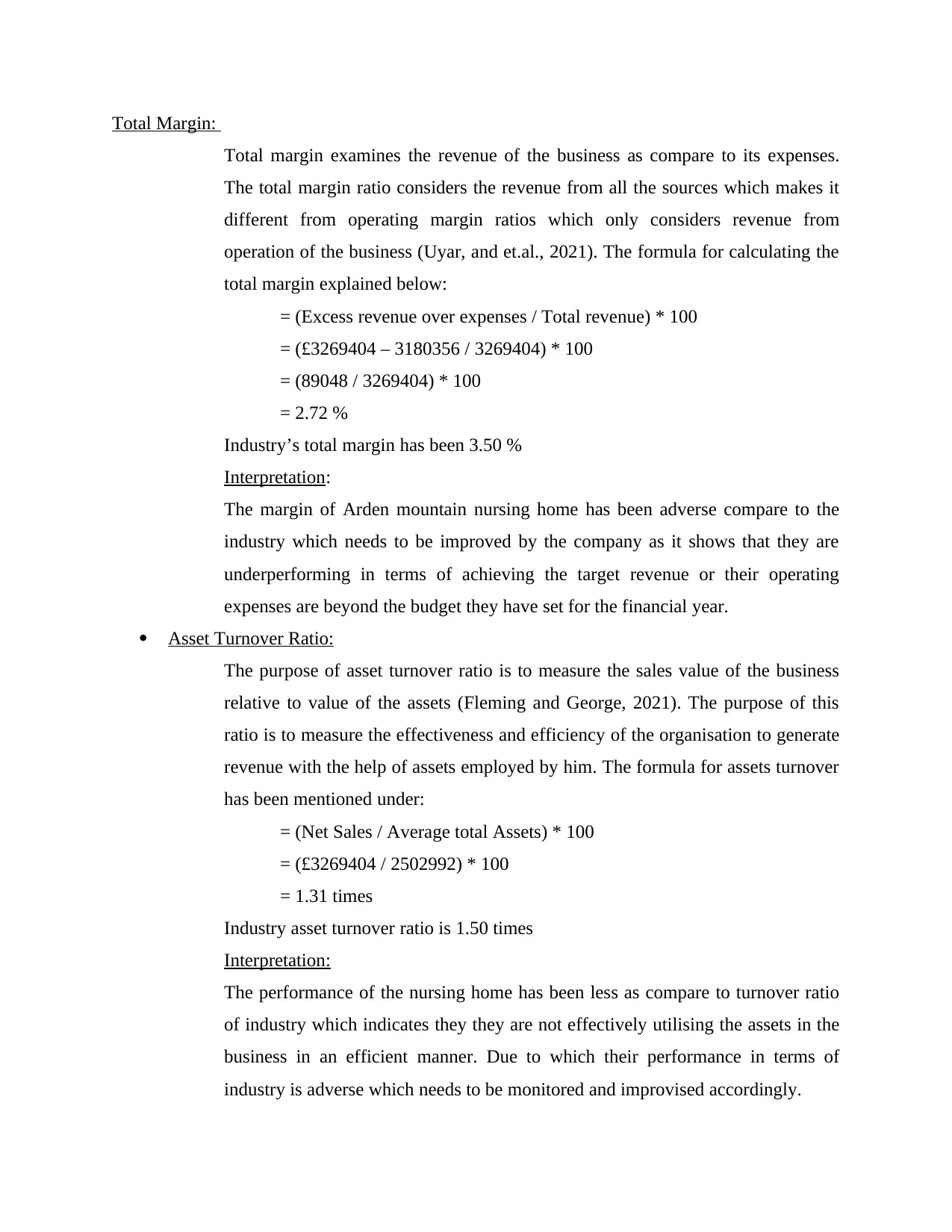
Total Margin:
Total margin examines the revenue of the business as compare to its expenses.
The total margin ratio considers the revenue from all the sources which makes it
different from operating margin ratios which only considers revenue from
operation of the business (Uyar, and et.al., 2021). The formula for calculating the
total margin explained below:
= (Excess revenue over expenses / Total revenue) * 100
= (£3269404 – 3180356 / 3269404) * 100
= (89048 / 3269404) * 100
= 2.72 %
Industry’s total margin has been 3.50 %
Interpretation:
The margin of Arden mountain nursing home has been adverse compare to the
industry which needs to be improved by the company as it shows that they are
underperforming in terms of achieving the target revenue or their operating
expenses are beyond the budget they have set for the financial year.
Asset Turnover Ratio:
The purpose of asset turnover ratio is to measure the sales value of the business
relative to value of the assets (Fleming and George, 2021). The purpose of this
ratio is to measure the effectiveness and efficiency of the organisation to generate
revenue with the help of assets employed by him. The formula for assets turnover
has been mentioned under:
= (Net Sales / Average total Assets) * 100
= (£3269404 / 2502992) * 100
= 1.31 times
Industry asset turnover ratio is 1.50 times
Interpretation:
The performance of the nursing home has been less as compare to turnover ratio
of industry which indicates they they are not effectively utilising the assets in the
business in an efficient manner. Due to which their performance in terms of
industry is adverse which needs to be monitored and improvised accordingly.
Total margin examines the revenue of the business as compare to its expenses.
The total margin ratio considers the revenue from all the sources which makes it
different from operating margin ratios which only considers revenue from
operation of the business (Uyar, and et.al., 2021). The formula for calculating the
total margin explained below:
= (Excess revenue over expenses / Total revenue) * 100
= (£3269404 – 3180356 / 3269404) * 100
= (89048 / 3269404) * 100
= 2.72 %
Industry’s total margin has been 3.50 %
Interpretation:
The margin of Arden mountain nursing home has been adverse compare to the
industry which needs to be improved by the company as it shows that they are
underperforming in terms of achieving the target revenue or their operating
expenses are beyond the budget they have set for the financial year.
Asset Turnover Ratio:
The purpose of asset turnover ratio is to measure the sales value of the business
relative to value of the assets (Fleming and George, 2021). The purpose of this
ratio is to measure the effectiveness and efficiency of the organisation to generate
revenue with the help of assets employed by him. The formula for assets turnover
has been mentioned under:
= (Net Sales / Average total Assets) * 100
= (£3269404 / 2502992) * 100
= 1.31 times
Industry asset turnover ratio is 1.50 times
Interpretation:
The performance of the nursing home has been less as compare to turnover ratio
of industry which indicates they they are not effectively utilising the assets in the
business in an efficient manner. Due to which their performance in terms of
industry is adverse which needs to be monitored and improvised accordingly.

Equity Multiplier:
The purpose of equity multiplier is to identify the risk which is situated in capital
structure of the organisation in the form of equity and debt that how much assets
of the business is financed by equity other than debt component (Thomas and
Rabiyathul Basariya, 2019). The formula of equity multiplier has been:
= (Total Assets / Shareholders equity)
= (2502992 / 357842)
= 6.99 times
The industry equity multiplier has been 2.50 times
Interpretation:
The equity portion of the company is higher which is 6.99 times as compares to
industry which is 2.50 times that shows that entity has employed funds from
equity more as compare to debt. The risk carried out by nursing home will be
lower when compared to other competitors.
Return on Equity:
The purpose of return on equity it to find out the amount of money which is left
with the organisation after the payment of dividend to the shareholders which
includes both payment made to equity and debt holders. The return on equity will
be calculated as under:
= (Net income / Shareholders equity)
= (57881 / 357842)
= 16.18 %
The industry’s return on equity has been 13.10%
Interpretation:
The nursing home has been performing well as compare to industry which is
3.08% better and it shows that they are utilising their workfare and assets in the
right direction. It is also helpful for the company to better their position in the
market against their competitors as well.
The purpose of equity multiplier is to identify the risk which is situated in capital
structure of the organisation in the form of equity and debt that how much assets
of the business is financed by equity other than debt component (Thomas and
Rabiyathul Basariya, 2019). The formula of equity multiplier has been:
= (Total Assets / Shareholders equity)
= (2502992 / 357842)
= 6.99 times
The industry equity multiplier has been 2.50 times
Interpretation:
The equity portion of the company is higher which is 6.99 times as compares to
industry which is 2.50 times that shows that entity has employed funds from
equity more as compare to debt. The risk carried out by nursing home will be
lower when compared to other competitors.
Return on Equity:
The purpose of return on equity it to find out the amount of money which is left
with the organisation after the payment of dividend to the shareholders which
includes both payment made to equity and debt holders. The return on equity will
be calculated as under:
= (Net income / Shareholders equity)
= (57881 / 357842)
= 16.18 %
The industry’s return on equity has been 13.10%
Interpretation:
The nursing home has been performing well as compare to industry which is
3.08% better and it shows that they are utilising their workfare and assets in the
right direction. It is also helpful for the company to better their position in the
market against their competitors as well.
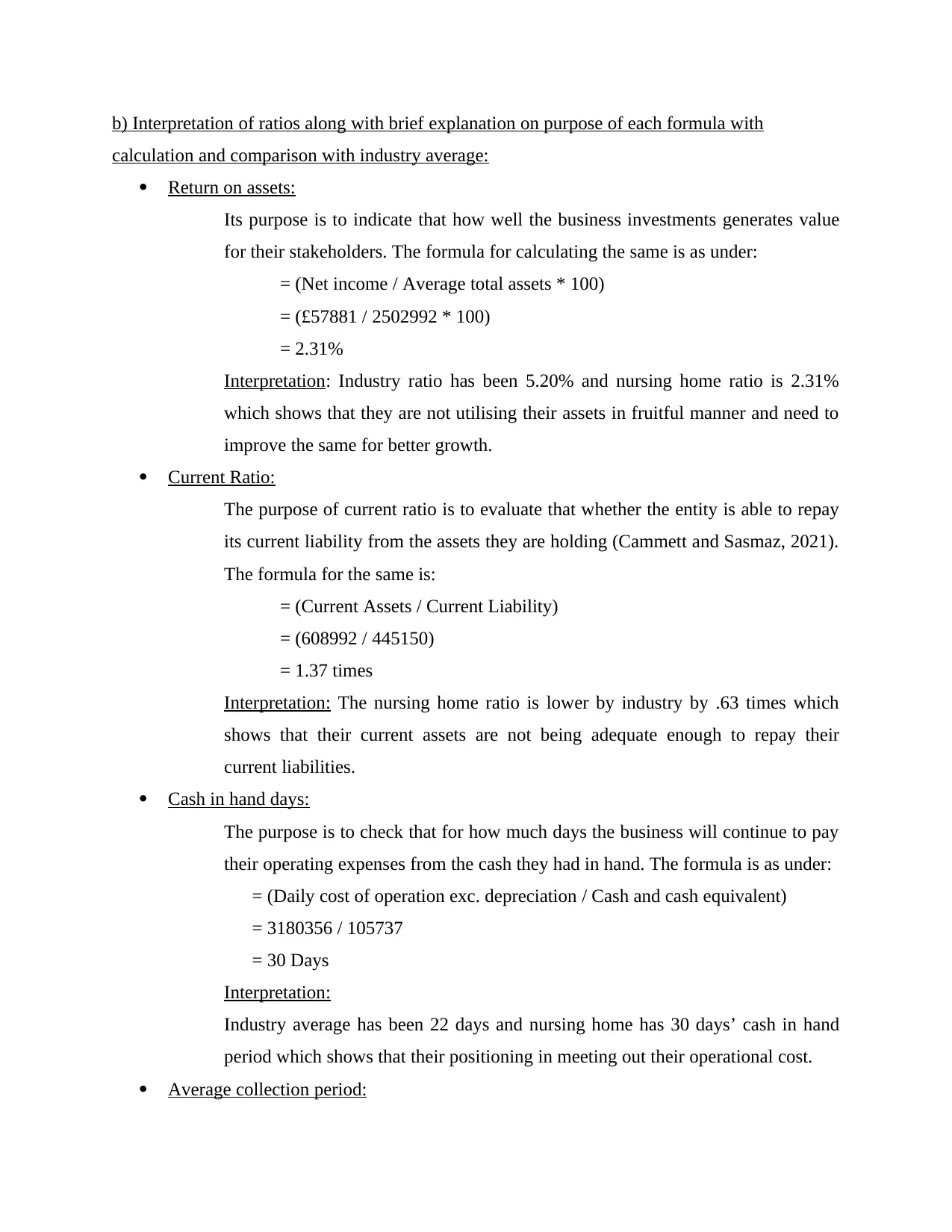
b) Interpretation of ratios along with brief explanation on purpose of each formula with
calculation and comparison with industry average:
Return on assets:
Its purpose is to indicate that how well the business investments generates value
for their stakeholders. The formula for calculating the same is as under:
= (Net income / Average total assets * 100)
= (£57881 / 2502992 * 100)
= 2.31%
Interpretation: Industry ratio has been 5.20% and nursing home ratio is 2.31%
which shows that they are not utilising their assets in fruitful manner and need to
improve the same for better growth.
Current Ratio:
The purpose of current ratio is to evaluate that whether the entity is able to repay
its current liability from the assets they are holding (Cammett and Sasmaz, 2021).
The formula for the same is:
= (Current Assets / Current Liability)
= (608992 / 445150)
= 1.37 times
Interpretation: The nursing home ratio is lower by industry by .63 times which
shows that their current assets are not being adequate enough to repay their
current liabilities.
Cash in hand days:
The purpose is to check that for how much days the business will continue to pay
their operating expenses from the cash they had in hand. The formula is as under:
= (Daily cost of operation exc. depreciation / Cash and cash equivalent)
= 3180356 / 105737
= 30 Days
Interpretation:
Industry average has been 22 days and nursing home has 30 days’ cash in hand
period which shows that their positioning in meeting out their operational cost.
Average collection period:
calculation and comparison with industry average:
Return on assets:
Its purpose is to indicate that how well the business investments generates value
for their stakeholders. The formula for calculating the same is as under:
= (Net income / Average total assets * 100)
= (£57881 / 2502992 * 100)
= 2.31%
Interpretation: Industry ratio has been 5.20% and nursing home ratio is 2.31%
which shows that they are not utilising their assets in fruitful manner and need to
improve the same for better growth.
Current Ratio:
The purpose of current ratio is to evaluate that whether the entity is able to repay
its current liability from the assets they are holding (Cammett and Sasmaz, 2021).
The formula for the same is:
= (Current Assets / Current Liability)
= (608992 / 445150)
= 1.37 times
Interpretation: The nursing home ratio is lower by industry by .63 times which
shows that their current assets are not being adequate enough to repay their
current liabilities.
Cash in hand days:
The purpose is to check that for how much days the business will continue to pay
their operating expenses from the cash they had in hand. The formula is as under:
= (Daily cost of operation exc. depreciation / Cash and cash equivalent)
= 3180356 / 105737
= 30 Days
Interpretation:
Industry average has been 22 days and nursing home has 30 days’ cash in hand
period which shows that their positioning in meeting out their operational cost.
Average collection period:
Secure Best Marks with AI Grader
Need help grading? Try our AI Grader for instant feedback on your assignments.
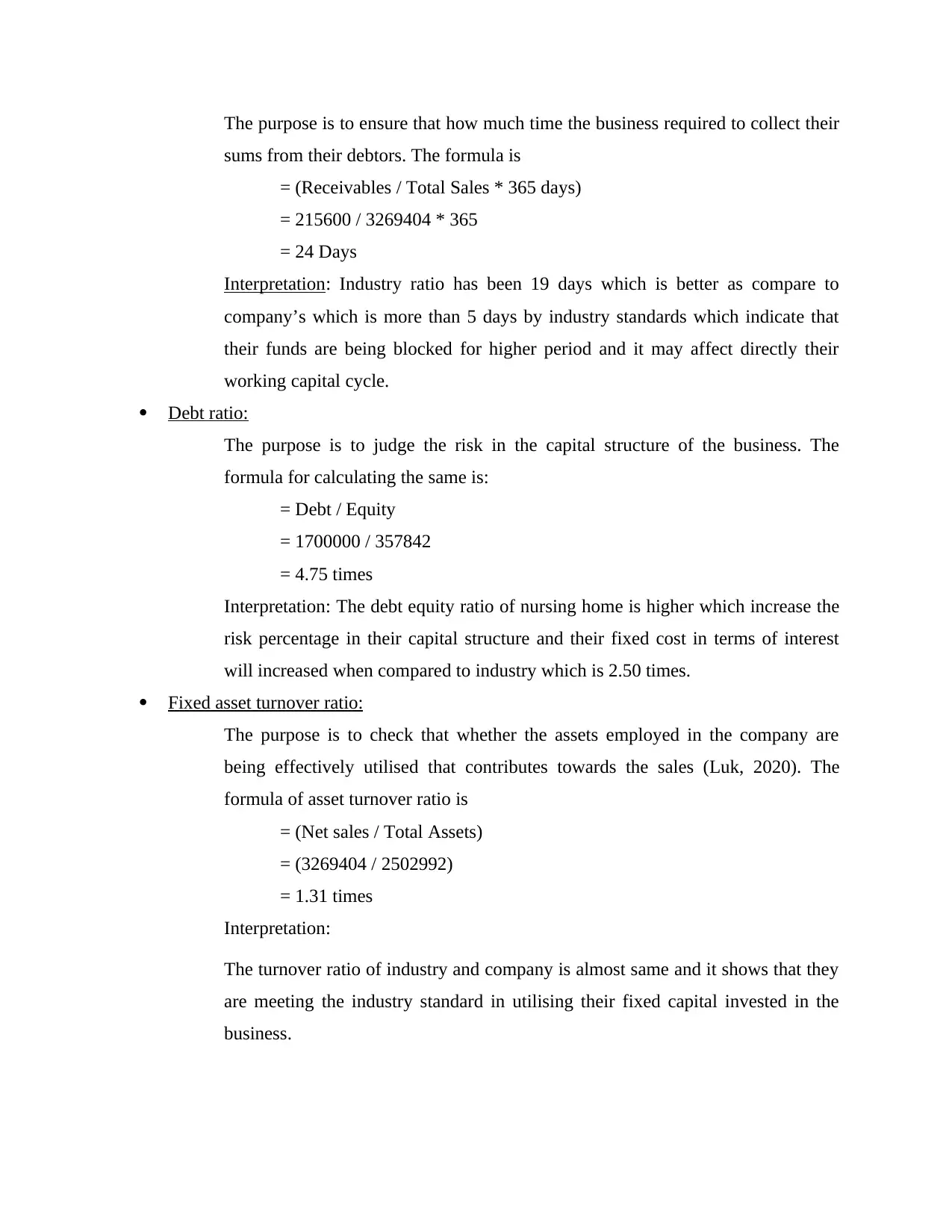
The purpose is to ensure that how much time the business required to collect their
sums from their debtors. The formula is
= (Receivables / Total Sales * 365 days)
= 215600 / 3269404 * 365
= 24 Days
Interpretation: Industry ratio has been 19 days which is better as compare to
company’s which is more than 5 days by industry standards which indicate that
their funds are being blocked for higher period and it may affect directly their
working capital cycle.
Debt ratio:
The purpose is to judge the risk in the capital structure of the business. The
formula for calculating the same is:
= Debt / Equity
= 1700000 / 357842
= 4.75 times
Interpretation: The debt equity ratio of nursing home is higher which increase the
risk percentage in their capital structure and their fixed cost in terms of interest
will increased when compared to industry which is 2.50 times.
Fixed asset turnover ratio:
The purpose is to check that whether the assets employed in the company are
being effectively utilised that contributes towards the sales (Luk, 2020). The
formula of asset turnover ratio is
= (Net sales / Total Assets)
= (3269404 / 2502992)
= 1.31 times
Interpretation:
The turnover ratio of industry and company is almost same and it shows that they
are meeting the industry standard in utilising their fixed capital invested in the
business.
sums from their debtors. The formula is
= (Receivables / Total Sales * 365 days)
= 215600 / 3269404 * 365
= 24 Days
Interpretation: Industry ratio has been 19 days which is better as compare to
company’s which is more than 5 days by industry standards which indicate that
their funds are being blocked for higher period and it may affect directly their
working capital cycle.
Debt ratio:
The purpose is to judge the risk in the capital structure of the business. The
formula for calculating the same is:
= Debt / Equity
= 1700000 / 357842
= 4.75 times
Interpretation: The debt equity ratio of nursing home is higher which increase the
risk percentage in their capital structure and their fixed cost in terms of interest
will increased when compared to industry which is 2.50 times.
Fixed asset turnover ratio:
The purpose is to check that whether the assets employed in the company are
being effectively utilised that contributes towards the sales (Luk, 2020). The
formula of asset turnover ratio is
= (Net sales / Total Assets)
= (3269404 / 2502992)
= 1.31 times
Interpretation:
The turnover ratio of industry and company is almost same and it shows that they
are meeting the industry standard in utilising their fixed capital invested in the
business.
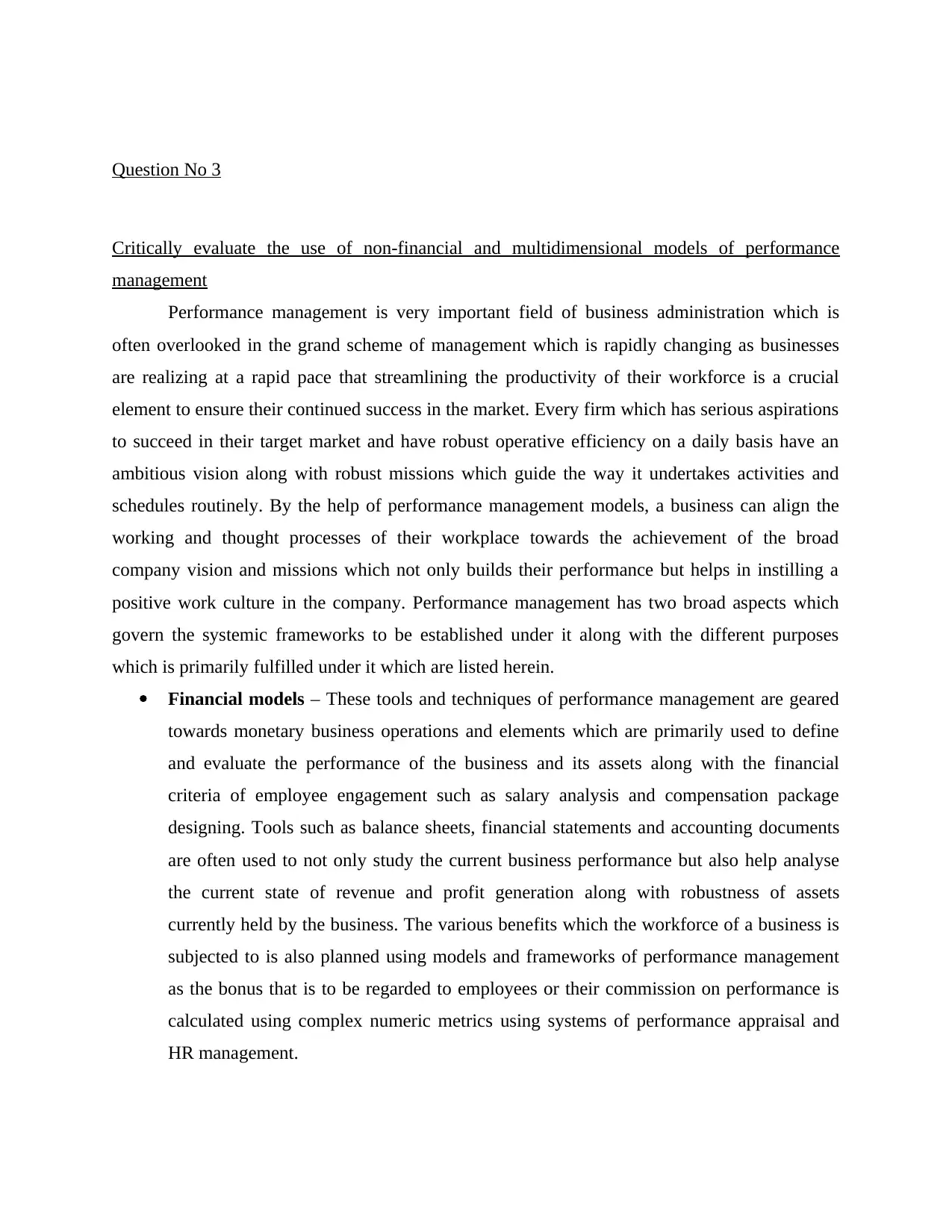
Question No 3
Critically evaluate the use of non-financial and multidimensional models of performance
management
Performance management is very important field of business administration which is
often overlooked in the grand scheme of management which is rapidly changing as businesses
are realizing at a rapid pace that streamlining the productivity of their workforce is a crucial
element to ensure their continued success in the market. Every firm which has serious aspirations
to succeed in their target market and have robust operative efficiency on a daily basis have an
ambitious vision along with robust missions which guide the way it undertakes activities and
schedules routinely. By the help of performance management models, a business can align the
working and thought processes of their workplace towards the achievement of the broad
company vision and missions which not only builds their performance but helps in instilling a
positive work culture in the company. Performance management has two broad aspects which
govern the systemic frameworks to be established under it along with the different purposes
which is primarily fulfilled under it which are listed herein.
Financial models – These tools and techniques of performance management are geared
towards monetary business operations and elements which are primarily used to define
and evaluate the performance of the business and its assets along with the financial
criteria of employee engagement such as salary analysis and compensation package
designing. Tools such as balance sheets, financial statements and accounting documents
are often used to not only study the current business performance but also help analyse
the current state of revenue and profit generation along with robustness of assets
currently held by the business. The various benefits which the workforce of a business is
subjected to is also planned using models and frameworks of performance management
as the bonus that is to be regarded to employees or their commission on performance is
calculated using complex numeric metrics using systems of performance appraisal and
HR management.
Critically evaluate the use of non-financial and multidimensional models of performance
management
Performance management is very important field of business administration which is
often overlooked in the grand scheme of management which is rapidly changing as businesses
are realizing at a rapid pace that streamlining the productivity of their workforce is a crucial
element to ensure their continued success in the market. Every firm which has serious aspirations
to succeed in their target market and have robust operative efficiency on a daily basis have an
ambitious vision along with robust missions which guide the way it undertakes activities and
schedules routinely. By the help of performance management models, a business can align the
working and thought processes of their workplace towards the achievement of the broad
company vision and missions which not only builds their performance but helps in instilling a
positive work culture in the company. Performance management has two broad aspects which
govern the systemic frameworks to be established under it along with the different purposes
which is primarily fulfilled under it which are listed herein.
Financial models – These tools and techniques of performance management are geared
towards monetary business operations and elements which are primarily used to define
and evaluate the performance of the business and its assets along with the financial
criteria of employee engagement such as salary analysis and compensation package
designing. Tools such as balance sheets, financial statements and accounting documents
are often used to not only study the current business performance but also help analyse
the current state of revenue and profit generation along with robustness of assets
currently held by the business. The various benefits which the workforce of a business is
subjected to is also planned using models and frameworks of performance management
as the bonus that is to be regarded to employees or their commission on performance is
calculated using complex numeric metrics using systems of performance appraisal and
HR management.
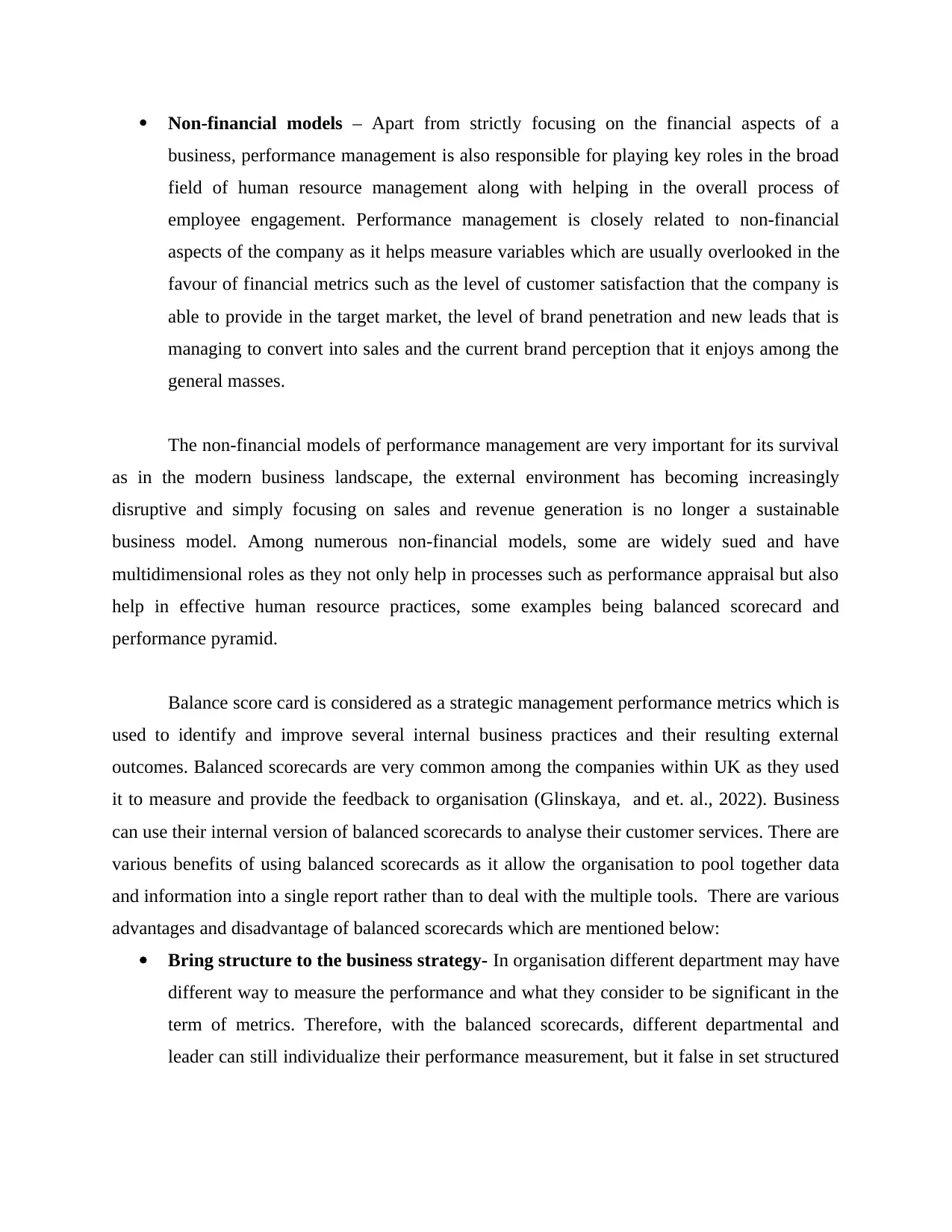
Non-financial models – Apart from strictly focusing on the financial aspects of a
business, performance management is also responsible for playing key roles in the broad
field of human resource management along with helping in the overall process of
employee engagement. Performance management is closely related to non-financial
aspects of the company as it helps measure variables which are usually overlooked in the
favour of financial metrics such as the level of customer satisfaction that the company is
able to provide in the target market, the level of brand penetration and new leads that is
managing to convert into sales and the current brand perception that it enjoys among the
general masses.
The non-financial models of performance management are very important for its survival
as in the modern business landscape, the external environment has becoming increasingly
disruptive and simply focusing on sales and revenue generation is no longer a sustainable
business model. Among numerous non-financial models, some are widely sued and have
multidimensional roles as they not only help in processes such as performance appraisal but also
help in effective human resource practices, some examples being balanced scorecard and
performance pyramid.
Balance score card is considered as a strategic management performance metrics which is
used to identify and improve several internal business practices and their resulting external
outcomes. Balanced scorecards are very common among the companies within UK as they used
it to measure and provide the feedback to organisation (Glinskaya, and et. al., 2022). Business
can use their internal version of balanced scorecards to analyse their customer services. There are
various benefits of using balanced scorecards as it allow the organisation to pool together data
and information into a single report rather than to deal with the multiple tools. There are various
advantages and disadvantage of balanced scorecards which are mentioned below:
Bring structure to the business strategy- In organisation different department may have
different way to measure the performance and what they consider to be significant in the
term of metrics. Therefore, with the balanced scorecards, different departmental and
leader can still individualize their performance measurement, but it false in set structured
business, performance management is also responsible for playing key roles in the broad
field of human resource management along with helping in the overall process of
employee engagement. Performance management is closely related to non-financial
aspects of the company as it helps measure variables which are usually overlooked in the
favour of financial metrics such as the level of customer satisfaction that the company is
able to provide in the target market, the level of brand penetration and new leads that is
managing to convert into sales and the current brand perception that it enjoys among the
general masses.
The non-financial models of performance management are very important for its survival
as in the modern business landscape, the external environment has becoming increasingly
disruptive and simply focusing on sales and revenue generation is no longer a sustainable
business model. Among numerous non-financial models, some are widely sued and have
multidimensional roles as they not only help in processes such as performance appraisal but also
help in effective human resource practices, some examples being balanced scorecard and
performance pyramid.
Balance score card is considered as a strategic management performance metrics which is
used to identify and improve several internal business practices and their resulting external
outcomes. Balanced scorecards are very common among the companies within UK as they used
it to measure and provide the feedback to organisation (Glinskaya, and et. al., 2022). Business
can use their internal version of balanced scorecards to analyse their customer services. There are
various benefits of using balanced scorecards as it allow the organisation to pool together data
and information into a single report rather than to deal with the multiple tools. There are various
advantages and disadvantage of balanced scorecards which are mentioned below:
Bring structure to the business strategy- In organisation different department may have
different way to measure the performance and what they consider to be significant in the
term of metrics. Therefore, with the balanced scorecards, different departmental and
leader can still individualize their performance measurement, but it false in set structured
Paraphrase This Document
Need a fresh take? Get an instant paraphrase of this document with our AI Paraphraser
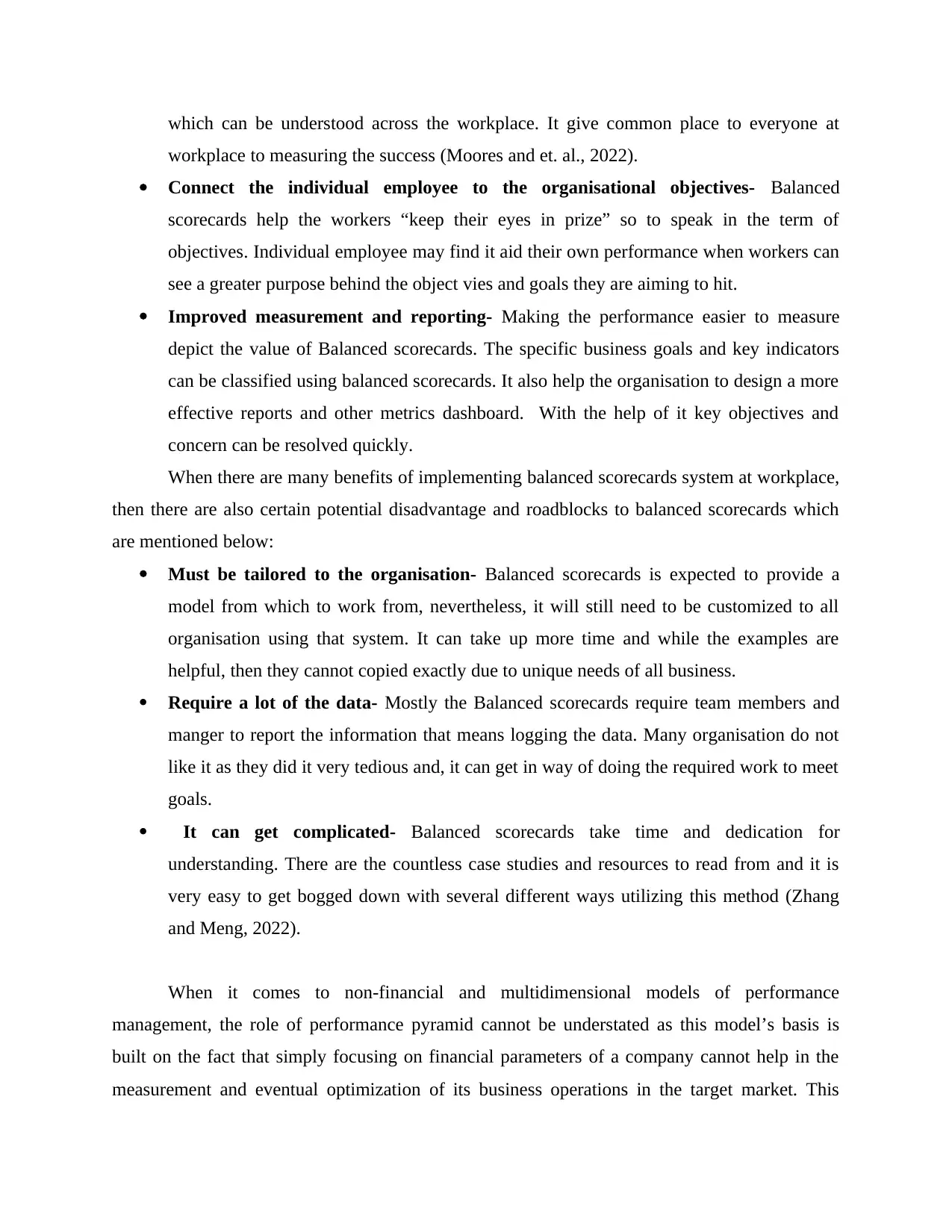
which can be understood across the workplace. It give common place to everyone at
workplace to measuring the success (Moores and et. al., 2022).
Connect the individual employee to the organisational objectives- Balanced
scorecards help the workers “keep their eyes in prize” so to speak in the term of
objectives. Individual employee may find it aid their own performance when workers can
see a greater purpose behind the object vies and goals they are aiming to hit.
Improved measurement and reporting- Making the performance easier to measure
depict the value of Balanced scorecards. The specific business goals and key indicators
can be classified using balanced scorecards. It also help the organisation to design a more
effective reports and other metrics dashboard. With the help of it key objectives and
concern can be resolved quickly.
When there are many benefits of implementing balanced scorecards system at workplace,
then there are also certain potential disadvantage and roadblocks to balanced scorecards which
are mentioned below:
Must be tailored to the organisation- Balanced scorecards is expected to provide a
model from which to work from, nevertheless, it will still need to be customized to all
organisation using that system. It can take up more time and while the examples are
helpful, then they cannot copied exactly due to unique needs of all business.
Require a lot of the data- Mostly the Balanced scorecards require team members and
manger to report the information that means logging the data. Many organisation do not
like it as they did it very tedious and, it can get in way of doing the required work to meet
goals.
It can get complicated- Balanced scorecards take time and dedication for
understanding. There are the countless case studies and resources to read from and it is
very easy to get bogged down with several different ways utilizing this method (Zhang
and Meng, 2022).
When it comes to non-financial and multidimensional models of performance
management, the role of performance pyramid cannot be understated as this model’s basis is
built on the fact that simply focusing on financial parameters of a company cannot help in the
measurement and eventual optimization of its business operations in the target market. This
workplace to measuring the success (Moores and et. al., 2022).
Connect the individual employee to the organisational objectives- Balanced
scorecards help the workers “keep their eyes in prize” so to speak in the term of
objectives. Individual employee may find it aid their own performance when workers can
see a greater purpose behind the object vies and goals they are aiming to hit.
Improved measurement and reporting- Making the performance easier to measure
depict the value of Balanced scorecards. The specific business goals and key indicators
can be classified using balanced scorecards. It also help the organisation to design a more
effective reports and other metrics dashboard. With the help of it key objectives and
concern can be resolved quickly.
When there are many benefits of implementing balanced scorecards system at workplace,
then there are also certain potential disadvantage and roadblocks to balanced scorecards which
are mentioned below:
Must be tailored to the organisation- Balanced scorecards is expected to provide a
model from which to work from, nevertheless, it will still need to be customized to all
organisation using that system. It can take up more time and while the examples are
helpful, then they cannot copied exactly due to unique needs of all business.
Require a lot of the data- Mostly the Balanced scorecards require team members and
manger to report the information that means logging the data. Many organisation do not
like it as they did it very tedious and, it can get in way of doing the required work to meet
goals.
It can get complicated- Balanced scorecards take time and dedication for
understanding. There are the countless case studies and resources to read from and it is
very easy to get bogged down with several different ways utilizing this method (Zhang
and Meng, 2022).
When it comes to non-financial and multidimensional models of performance
management, the role of performance pyramid cannot be understated as this model’s basis is
built on the fact that simply focusing on financial parameters of a company cannot help in the
measurement and eventual optimization of its business operations in the target market. This
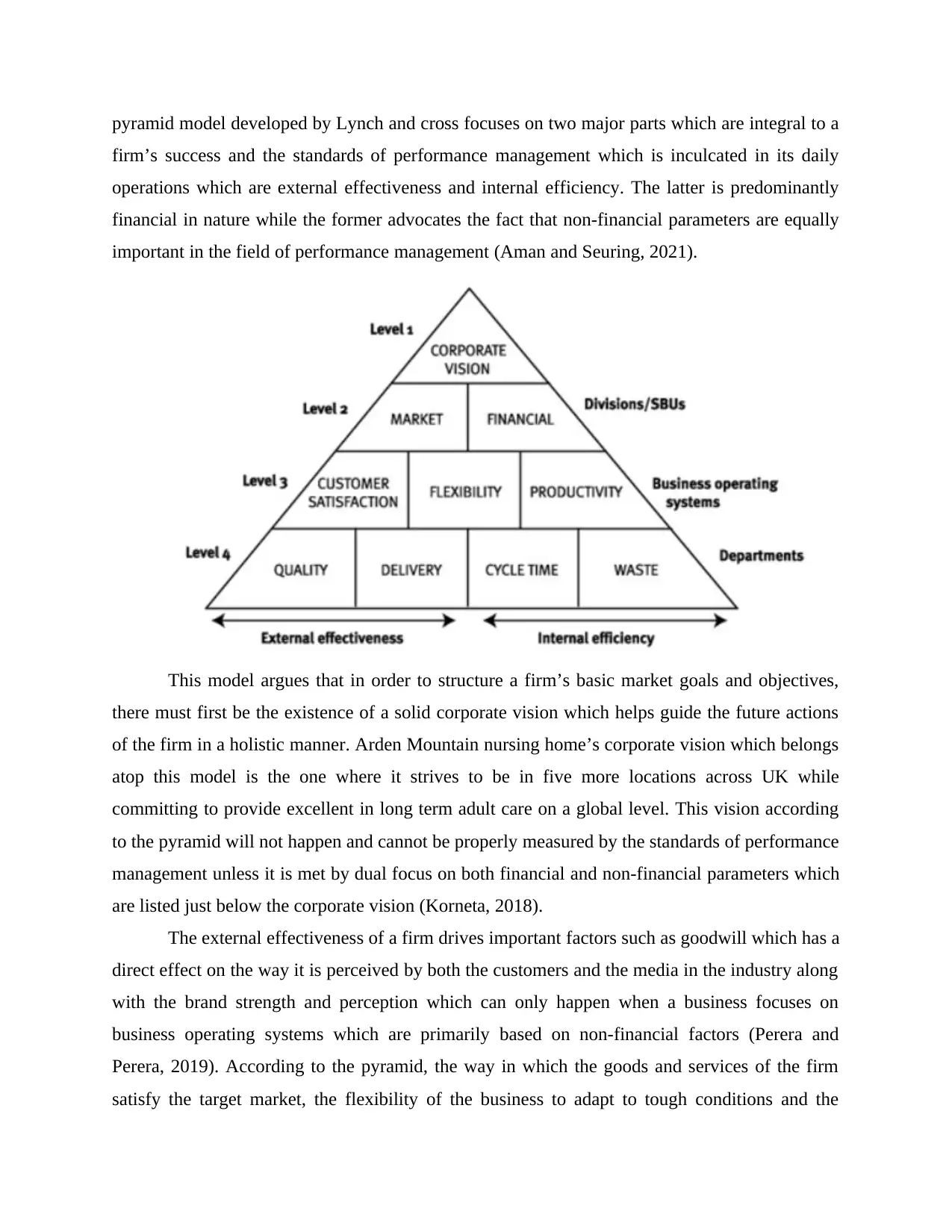
pyramid model developed by Lynch and cross focuses on two major parts which are integral to a
firm’s success and the standards of performance management which is inculcated in its daily
operations which are external effectiveness and internal efficiency. The latter is predominantly
financial in nature while the former advocates the fact that non-financial parameters are equally
important in the field of performance management (Aman and Seuring, 2021).
This model argues that in order to structure a firm’s basic market goals and objectives,
there must first be the existence of a solid corporate vision which helps guide the future actions
of the firm in a holistic manner. Arden Mountain nursing home’s corporate vision which belongs
atop this model is the one where it strives to be in five more locations across UK while
committing to provide excellent in long term adult care on a global level. This vision according
to the pyramid will not happen and cannot be properly measured by the standards of performance
management unless it is met by dual focus on both financial and non-financial parameters which
are listed just below the corporate vision (Korneta, 2018).
The external effectiveness of a firm drives important factors such as goodwill which has a
direct effect on the way it is perceived by both the customers and the media in the industry along
with the brand strength and perception which can only happen when a business focuses on
business operating systems which are primarily based on non-financial factors (Perera and
Perera, 2019). According to the pyramid, the way in which the goods and services of the firm
satisfy the target market, the flexibility of the business to adapt to tough conditions and the
firm’s success and the standards of performance management which is inculcated in its daily
operations which are external effectiveness and internal efficiency. The latter is predominantly
financial in nature while the former advocates the fact that non-financial parameters are equally
important in the field of performance management (Aman and Seuring, 2021).
This model argues that in order to structure a firm’s basic market goals and objectives,
there must first be the existence of a solid corporate vision which helps guide the future actions
of the firm in a holistic manner. Arden Mountain nursing home’s corporate vision which belongs
atop this model is the one where it strives to be in five more locations across UK while
committing to provide excellent in long term adult care on a global level. This vision according
to the pyramid will not happen and cannot be properly measured by the standards of performance
management unless it is met by dual focus on both financial and non-financial parameters which
are listed just below the corporate vision (Korneta, 2018).
The external effectiveness of a firm drives important factors such as goodwill which has a
direct effect on the way it is perceived by both the customers and the media in the industry along
with the brand strength and perception which can only happen when a business focuses on
business operating systems which are primarily based on non-financial factors (Perera and
Perera, 2019). According to the pyramid, the way in which the goods and services of the firm
satisfy the target market, the flexibility of the business to adapt to tough conditions and the
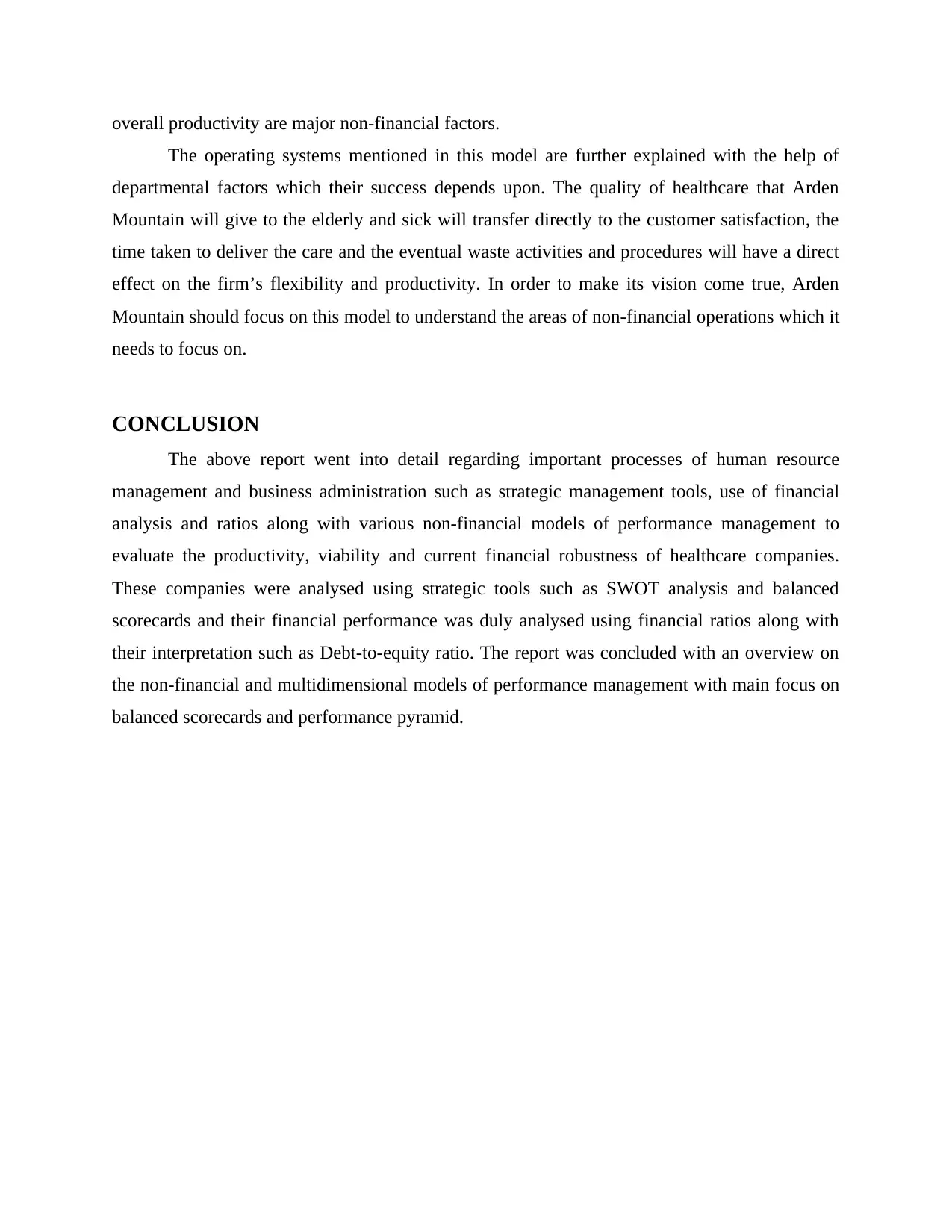
overall productivity are major non-financial factors.
The operating systems mentioned in this model are further explained with the help of
departmental factors which their success depends upon. The quality of healthcare that Arden
Mountain will give to the elderly and sick will transfer directly to the customer satisfaction, the
time taken to deliver the care and the eventual waste activities and procedures will have a direct
effect on the firm’s flexibility and productivity. In order to make its vision come true, Arden
Mountain should focus on this model to understand the areas of non-financial operations which it
needs to focus on.
CONCLUSION
The above report went into detail regarding important processes of human resource
management and business administration such as strategic management tools, use of financial
analysis and ratios along with various non-financial models of performance management to
evaluate the productivity, viability and current financial robustness of healthcare companies.
These companies were analysed using strategic tools such as SWOT analysis and balanced
scorecards and their financial performance was duly analysed using financial ratios along with
their interpretation such as Debt-to-equity ratio. The report was concluded with an overview on
the non-financial and multidimensional models of performance management with main focus on
balanced scorecards and performance pyramid.
The operating systems mentioned in this model are further explained with the help of
departmental factors which their success depends upon. The quality of healthcare that Arden
Mountain will give to the elderly and sick will transfer directly to the customer satisfaction, the
time taken to deliver the care and the eventual waste activities and procedures will have a direct
effect on the firm’s flexibility and productivity. In order to make its vision come true, Arden
Mountain should focus on this model to understand the areas of non-financial operations which it
needs to focus on.
CONCLUSION
The above report went into detail regarding important processes of human resource
management and business administration such as strategic management tools, use of financial
analysis and ratios along with various non-financial models of performance management to
evaluate the productivity, viability and current financial robustness of healthcare companies.
These companies were analysed using strategic tools such as SWOT analysis and balanced
scorecards and their financial performance was duly analysed using financial ratios along with
their interpretation such as Debt-to-equity ratio. The report was concluded with an overview on
the non-financial and multidimensional models of performance management with main focus on
balanced scorecards and performance pyramid.
Secure Best Marks with AI Grader
Need help grading? Try our AI Grader for instant feedback on your assignments.
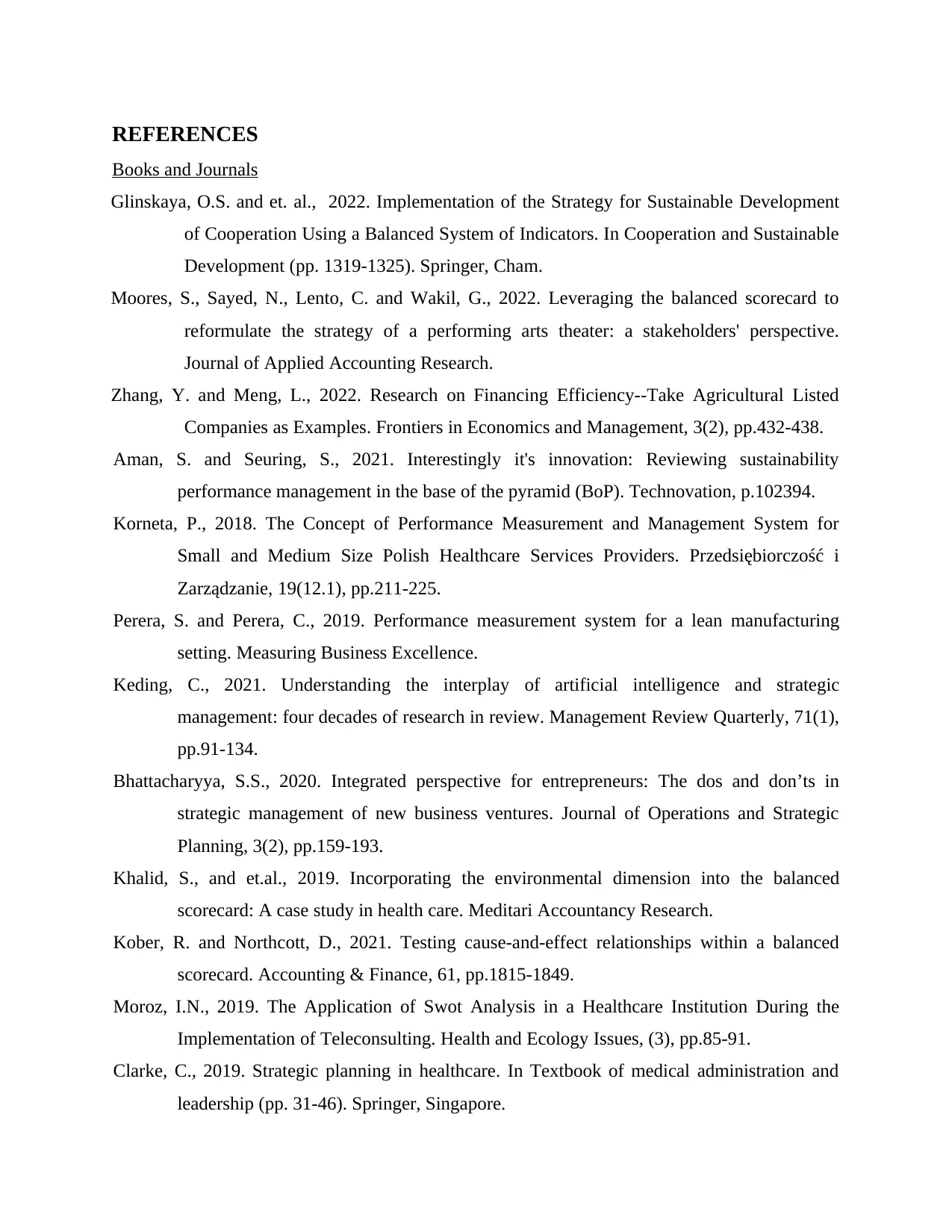
REFERENCES
Books and Journals
Glinskaya, O.S. and et. al., 2022. Implementation of the Strategy for Sustainable Development
of Cooperation Using a Balanced System of Indicators. In Сooperation and Sustainable
Development (pp. 1319-1325). Springer, Cham.
Moores, S., Sayed, N., Lento, C. and Wakil, G., 2022. Leveraging the balanced scorecard to
reformulate the strategy of a performing arts theater: a stakeholders' perspective.
Journal of Applied Accounting Research.
Zhang, Y. and Meng, L., 2022. Research on Financing Efficiency--Take Agricultural Listed
Companies as Examples. Frontiers in Economics and Management, 3(2), pp.432-438.
Aman, S. and Seuring, S., 2021. Interestingly it's innovation: Reviewing sustainability
performance management in the base of the pyramid (BoP). Technovation, p.102394.
Korneta, P., 2018. The Concept of Performance Measurement and Management System for
Small and Medium Size Polish Healthcare Services Providers. Przedsiębiorczość i
Zarządzanie, 19(12.1), pp.211-225.
Perera, S. and Perera, C., 2019. Performance measurement system for a lean manufacturing
setting. Measuring Business Excellence.
Keding, C., 2021. Understanding the interplay of artificial intelligence and strategic
management: four decades of research in review. Management Review Quarterly, 71(1),
pp.91-134.
Bhattacharyya, S.S., 2020. Integrated perspective for entrepreneurs: The dos and don’ts in
strategic management of new business ventures. Journal of Operations and Strategic
Planning, 3(2), pp.159-193.
Khalid, S., and et.al., 2019. Incorporating the environmental dimension into the balanced
scorecard: A case study in health care. Meditari Accountancy Research.
Kober, R. and Northcott, D., 2021. Testing cause‐and‐effect relationships within a balanced
scorecard. Accounting & Finance, 61, pp.1815-1849.
Moroz, I.N., 2019. The Application of Swot Analysis in a Healthcare Institution During the
Implementation of Teleconsulting. Health and Ecology Issues, (3), pp.85-91.
Clarke, C., 2019. Strategic planning in healthcare. In Textbook of medical administration and
leadership (pp. 31-46). Springer, Singapore.
Books and Journals
Glinskaya, O.S. and et. al., 2022. Implementation of the Strategy for Sustainable Development
of Cooperation Using a Balanced System of Indicators. In Сooperation and Sustainable
Development (pp. 1319-1325). Springer, Cham.
Moores, S., Sayed, N., Lento, C. and Wakil, G., 2022. Leveraging the balanced scorecard to
reformulate the strategy of a performing arts theater: a stakeholders' perspective.
Journal of Applied Accounting Research.
Zhang, Y. and Meng, L., 2022. Research on Financing Efficiency--Take Agricultural Listed
Companies as Examples. Frontiers in Economics and Management, 3(2), pp.432-438.
Aman, S. and Seuring, S., 2021. Interestingly it's innovation: Reviewing sustainability
performance management in the base of the pyramid (BoP). Technovation, p.102394.
Korneta, P., 2018. The Concept of Performance Measurement and Management System for
Small and Medium Size Polish Healthcare Services Providers. Przedsiębiorczość i
Zarządzanie, 19(12.1), pp.211-225.
Perera, S. and Perera, C., 2019. Performance measurement system for a lean manufacturing
setting. Measuring Business Excellence.
Keding, C., 2021. Understanding the interplay of artificial intelligence and strategic
management: four decades of research in review. Management Review Quarterly, 71(1),
pp.91-134.
Bhattacharyya, S.S., 2020. Integrated perspective for entrepreneurs: The dos and don’ts in
strategic management of new business ventures. Journal of Operations and Strategic
Planning, 3(2), pp.159-193.
Khalid, S., and et.al., 2019. Incorporating the environmental dimension into the balanced
scorecard: A case study in health care. Meditari Accountancy Research.
Kober, R. and Northcott, D., 2021. Testing cause‐and‐effect relationships within a balanced
scorecard. Accounting & Finance, 61, pp.1815-1849.
Moroz, I.N., 2019. The Application of Swot Analysis in a Healthcare Institution During the
Implementation of Teleconsulting. Health and Ecology Issues, (3), pp.85-91.
Clarke, C., 2019. Strategic planning in healthcare. In Textbook of medical administration and
leadership (pp. 31-46). Springer, Singapore.
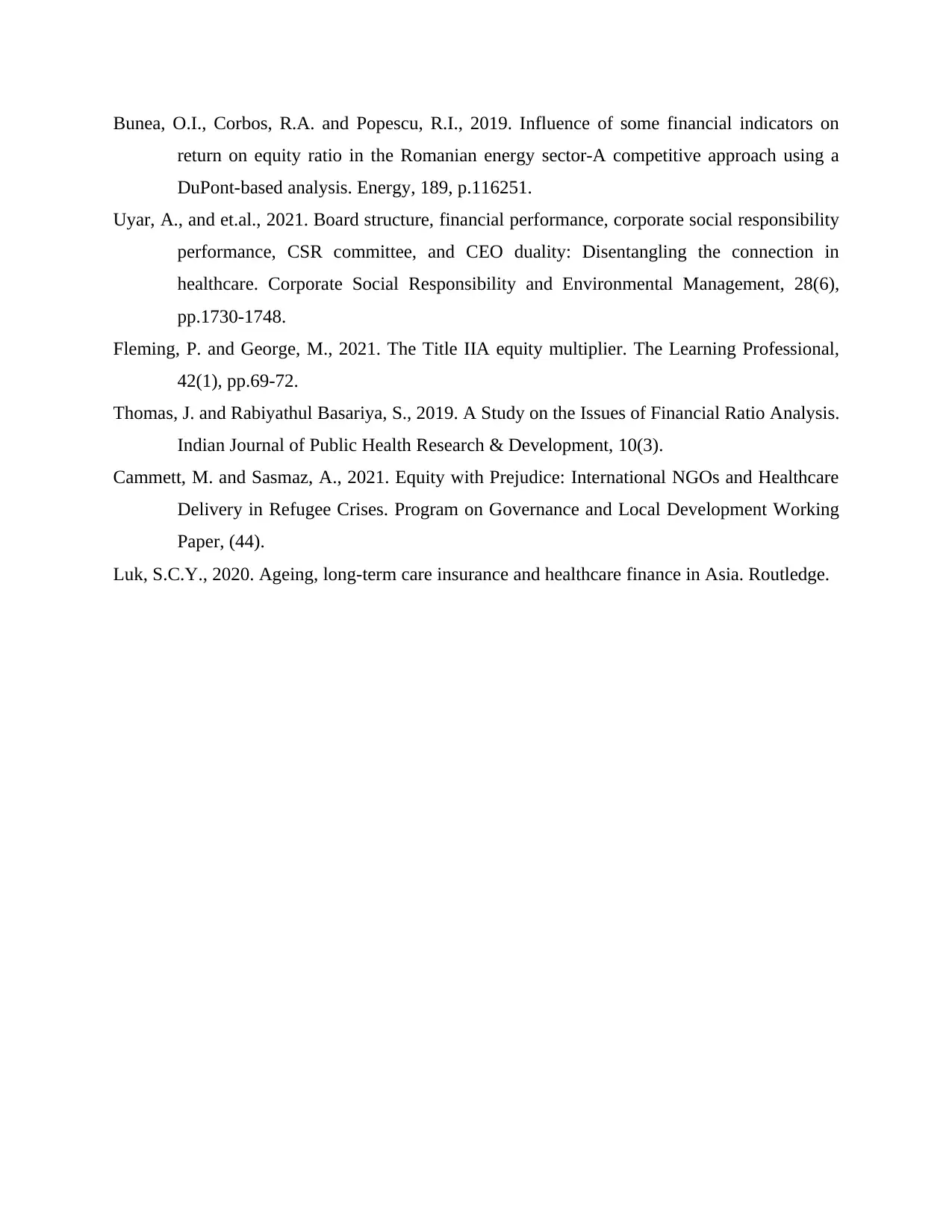
Bunea, O.I., Corbos, R.A. and Popescu, R.I., 2019. Influence of some financial indicators on
return on equity ratio in the Romanian energy sector-A competitive approach using a
DuPont-based analysis. Energy, 189, p.116251.
Uyar, A., and et.al., 2021. Board structure, financial performance, corporate social responsibility
performance, CSR committee, and CEO duality: Disentangling the connection in
healthcare. Corporate Social Responsibility and Environmental Management, 28(6),
pp.1730-1748.
Fleming, P. and George, M., 2021. The Title IIA equity multiplier. The Learning Professional,
42(1), pp.69-72.
Thomas, J. and Rabiyathul Basariya, S., 2019. A Study on the Issues of Financial Ratio Analysis.
Indian Journal of Public Health Research & Development, 10(3).
Cammett, M. and Sasmaz, A., 2021. Equity with Prejudice: International NGOs and Healthcare
Delivery in Refugee Crises. Program on Governance and Local Development Working
Paper, (44).
Luk, S.C.Y., 2020. Ageing, long-term care insurance and healthcare finance in Asia. Routledge.
return on equity ratio in the Romanian energy sector-A competitive approach using a
DuPont-based analysis. Energy, 189, p.116251.
Uyar, A., and et.al., 2021. Board structure, financial performance, corporate social responsibility
performance, CSR committee, and CEO duality: Disentangling the connection in
healthcare. Corporate Social Responsibility and Environmental Management, 28(6),
pp.1730-1748.
Fleming, P. and George, M., 2021. The Title IIA equity multiplier. The Learning Professional,
42(1), pp.69-72.
Thomas, J. and Rabiyathul Basariya, S., 2019. A Study on the Issues of Financial Ratio Analysis.
Indian Journal of Public Health Research & Development, 10(3).
Cammett, M. and Sasmaz, A., 2021. Equity with Prejudice: International NGOs and Healthcare
Delivery in Refugee Crises. Program on Governance and Local Development Working
Paper, (44).
Luk, S.C.Y., 2020. Ageing, long-term care insurance and healthcare finance in Asia. Routledge.
1 out of 18
Related Documents
Your All-in-One AI-Powered Toolkit for Academic Success.
+13062052269
info@desklib.com
Available 24*7 on WhatsApp / Email
![[object Object]](/_next/static/media/star-bottom.7253800d.svg)
Unlock your academic potential
© 2024 | Zucol Services PVT LTD | All rights reserved.



